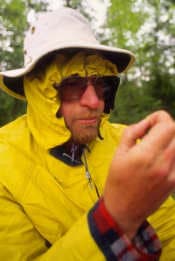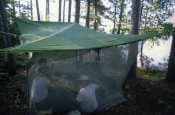What's Bugging You?
And the black flies, the little black flies Always the black fly no matter where you go I'll die with the black fly a-pickin' on my bones In North Ontario, io, in North Ontario. -Chorus from "The Blackfly Song" by Wade Hemsworth
Expert entomologists have stated that a person in the northern woods, without wearing the proper protective clothing, could actually die of blood loss in less than two hours as a result of severe blackfly and mosquito bites. Of course it's only a theory. None of these bug authorities has ever been crazy enough to stand naked in a forest and allow them selves to be bitten alive. However, after spending a good amount of time in the outdoors during prime bug season I can relate. There's only a slight lapse in their hypothesis. I think it would only take you an hour to drop dead.
Blackfly
The first bothersome bug to hatch in early spring is the blackfly. Unlike the mosquito which lays its eggs on the smooth surface of a pond, marsh or stagnant puddle, the blackfly lays its eggs in a running brook or river.
After hatching, the baby blackfly (larvae) drifts downstream, holding on to a strand of silk like a spider to its web on a windy day. Once it finds a place to feed, the blackfly then spins a disk-shaped pad of silk on a rock or log; holds itself in place with its hooked rear end; and begins to snack on tiny bacteria, protozoa, diatoms, and even the odd brother and sister blackfly that drifts by.

When the blackfly grows into an adult, the bug pulls itself out of its skin, stretches out its wings, rises quickly to the surface in a tiny gas bubble, and "pops" itself free. The males fly off to munch on plant nectar. The females, however, search out a victim for a meal of protein-rich blood, which it needs to produce its eggs.
Mosquito
The female mosquito is also the only one that feeds on blood. They also hatch in a similar way to the blackfly. The only real difference is the way they get their blood meal. Female blackflies feed by slicing your skin open with jagged mouthparts, like a pair of scissors. After the initial cut, other mouthparts (called stylets) hold back the skin with tiny hooks while the insect snips again and again until it eventually carves open your capillaries and tastes blood. It then fills up with half a teaspoon (two milliliters) of enriched protein.
The victim usually doesn't feel the blackfly cutting away. It's after she finishes and then wrenches her head from side to side, trying to free the hooked mouth part - that really hurts.
Unlike the blackfly, mosquitoes don't actually bite. They suck your blood. Using a needle-like mouthpart, the bug pierces your skin, spits saliva into the wound to stop your blood from clotting, fills its blood bank, then quickly pulls out and flies away.
Diseases spread by mosquitoes:
- Malaria
- Dengue fever
- Encephalitis (sleeping sickness)
- Elephantiasis
- Yellow fever
- West Nile Virus
Symptoms of West Nile
The symptoms of severe infection (West Nile encephalitis or meningitis) include headache, high fever, neck stiffness, stupor, disorientation, coma, tremors, convulsions, muscle weakness, and paralysis. It is estimated that 1 in 150 persons infected with the West Nile virus will develop a more severe form of disease.
Something to think about: The chance that any one person is going to become ill from West Nile Virus after being bitten by a mosquito remains low. Most people who are infected with the virus will not develop any symptoms at all.
Other Flies I Have Known
Horseflies and Deerflies
Horseflies and deerflies have to be on top of the list. These bothersome insects are not only one of the most fierce, painful biters; they're also excellent fliers, having the ability to chase you down the trail or portage (the record speed for a horsefly is 112 km/hr. or 67 mph). They're well known for patiently "buzzing" around your head until they find a safe place to land, and are mostly attracted to shinny objects, which is why the shimmer of wet skin on swimmers draws them in for miles around. Their bites are also the most infectious; first because they are carriers of such diseases as anthrax, tularemia and hog cholera; and second because they literally take a chunk of skin out of you, leaving behind a trail of blood and an open wound which can cause severe secondary infection.

The deerfly usually hunt in groups of four to five and is the most common of the two pests, which is a good thing since horse flies are almost three times the size. The deer fly is slightly larger than a house fly, has a yellow to light brown abdomen with darker stripes, a darker pattern to the wings, and bright green or gold eyes.
Sand fly
Another irritating insect is the sandfly, or what's more commonly known as "no-see'-ums." I hate these miniature pests, especially because they have the ability to squeeze themselves through the fine bug-mesh sewn to your tent door. There have been a few nights, especially in the province of Quebec, where I've camped on a scenic sandbar and quickly become overwhelmed by these tiny midges. They're almost impossible to see, and just as difficult to hear. But their bite is a nasty one. It feels like a hot ash from the campfire landing on your bare skin. In fact, a second nickname for them is "punkies," derived from the Native word "punk," meaning "living ashes."
Stable fly
Stable flies are also quite annoying. Many people mistake these bugs for biting house flies. They do have some resemblance. But make no mistake, these things really hurt. They usually go for the ankles and are equipped with a sharp, piercing mouthpart capable of penetrating the thickest of wool socks. Unlike other biting insects, which snip and slice, stable flies jab their slender proboscis into your skin. Then, miniature recurved spines at the tip of the proboscis grab hold while the mouth part is moved from side-to-side, enabling the insect to get deeper and deeper. The worst part, however, is both the male and female bite.
Ticks
The very worst out there, in my opinion, is the tick. The very thought of having one of these parasites feeding on you is enough to make your skin crawl. It's not so much that they are known vectors of Lyme disease and that they feed by plunging their beaklike mouthpart deep inside you and then secrete a cement-like saliva which literally glues them in place. It's the fact that they prefer dark and moist places on your body to attach themselves to; places like armpits, bellybutton holes, and, you guessed it, your crotch. These are all places I'd rather not have something nibbling at.
Performing regular tick checks are crucial in heavily tick infested areas. It's best to use the buddy system for this. Of course, this can get embarrassing at times. I'll never forget when my wife and I, while traveling through the Boundary Waters Canoe Area, began our nightly routine of stripping down and checking each other's private parts for embedded ticks, when a group of Boy Scouts paddled by. I tried to explain to them what we were doing, which, according to my wife, made the scenario even worse.
If you do find a tick lodged into your skin, make sure not to panic and start yanking away at it. You're just liable to pull the thing in half, leaving its head inside you and increase the chances of infection. The best way is to first spray it with a good amount of bug repellent. This will definitely force it to relax its grip, since the tick actually breaths out of its butt while its head is lodged into your skin. Don't burn it with a cigarette or match like some older guide books recommend. This will just make the tick hold on tighter and become more difficult to get out. After allowing some time for the repellent to take effect, place a pair of tweezers (tick pliers can also be purchased at most outdoor stores), and, without squeezing the tick, reach inside, beneath the body, and gently pull it out. Then disinfect the area with antiseptic or soap and water.
Symptoms of Lyme disease:
- A circular red rash forming around the bitten area
- Flu-like symptoms
- Painful joints
- Insomnia
- Local paralysis
- Skin sensations
- Hearing loss
How to Repel the Little Buggers
All blood feeding insects find their prey by body temperature, activated by lactic acid produced by muscle movement and the carbon dioxide emitted when you exhale. They absolutely love warm sweaty skin on a cool day. Warm days, however, seem to confuse them. All species also dislike pouring rain, cold days when temperatures reach below 30 F (10 C), and blowing winds; the blackfly in particular is not a strong flyer and can only reach a top speed of half-a-mile (one kilometer) per hour.

Dark colors attract much more than shiny bright colors. Wearing blue jeans is just asking for it; lime green neither attracts them nor keeps them at bay; and hot pink works great. Bug hats, or better yet, bug jackets are an essential part of your equipment list from the first week in May until around the second week in July. Bug repellent is also a must. There are lots of formulas out there but the best is anything that contains lots of DEET (Diethyl Toluamide). The chemical is mostly effective in keeping blackflies, mosquitoes, no-see-ums, and ticks away from your exposed skin. I wouldn't squirt too much on, however. The stuff also works well as striping paint and melting plastic. I remember back during my tree planting days for the Ministry of Natural Resources in Northern Ontario, we were told never to put DEET on our hard hats. One worker ignored our supervisor's rule one day and soaked his helmet. He got caught when the foreman saw thousands of dead blackflies stuck to his bright yellow hard hat. To show the reasoning behind the rule the boss smacked the hard hat against a rock. The plastic headgear cracked right down the middle. After witnessing that, I've kept to only putting small amounts of DEET directly on my skin. Usually I just spray the chemical on my bandana wrapped around my neck. I also make sure to keep my shirt sleeves and pant legs tight with elastic bands.
Repellents containing citron like Avon's Skin-So-Soft hand lotion are more gentle to the skin and are almost as effective as DEET. They usually don't last as long though. Taking vitamin B tablets three months prior to your trip has also been proven effective. Eating lots of citrus fruit and garlic, and avoiding bananas, are other suggestions to think about. Even applying a combination of spices - cinnamon, rosemary, basil, thyme and allspice - to your skin may work.

But my all-time favorite weaponry against bugs is my Eureka Bug Tarp. The bug shelter (titled "VCS Parawing shelter system" in the Eureka catalogue) is a regular rain tarp with a fine mesh netting attached to the four walls. The whole outfit weights about five pounds. It also uses no-see-um netting, which makes the price is a little high but far more effective against "punkies." The netting is attached to the four walls by plastic clips, making it possible to detach that section and just pack the tarp along during less buggy conditions.
My regular canoe mates teased me to no end the first time I brought the tarp along on our annual Spring fishing trip. They said I was a sissy. However, when the bugs got really bad and I went inside my bug proof shelter to cook up dinner in peace, they pleaded with me to be allowed in. Payment was a shot of brandy each and an immediate apology for calling me names.
So, what's bugging you?
Kevin Callan is the author of eight books including 'The Happy Camper: An Essential Guide to Life Outdoors'. He is a recipient of the National Magazine Award and a regularly featured speaker at North America's largest paddling events.
Related Articles
From what type of leader to use, how to tie your knots, type of hook and bait as well has how to cast…
Learn about the slow resurgence of humpback whales in Howe Sound, BC. After nearly hunting them to…
Patience is like a secure eddy in the middle of a raging rapid.It gives you time to formulate a plan…
Mention guns and canoe trips in the same breath and some folks are apt to go ballistic. Still, if you're…



